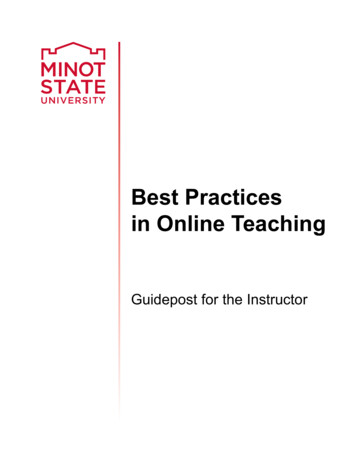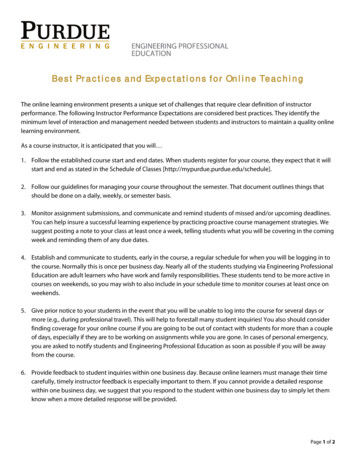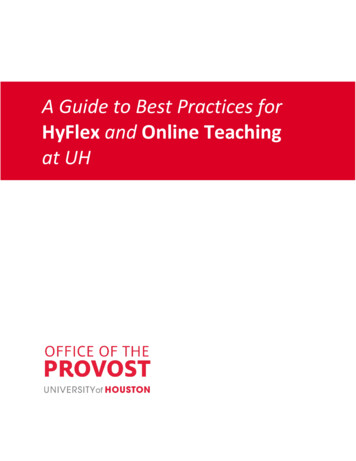
Transcription
Best Practicesin Online TeachingGuidepost for the Instructor
Best Practices in Online TeachingBest Practicesin OnlineTeachingGuidepost for the InstructorWhen preparing to teach online there are variousbest practices you should consider incorporating intoyour teaching strategies. In this short paper, we willdiscuss a few of these time-proven, research-basedpractices. But, before you start, there is one bestpractice that deserves highlighting.Best practice #1 is the recognition thatteaching Online is not the same as teachingface-to-face so don’t try to do it the sameway.7.Respects diverse talents and ways oflearning.Build Online CommunityThere is a growing trend in the e-learning communityto use the first week of class to develop an effectiveonline student community before advancing intocontent. This emphasizes its importance as part ofthe e-learning experience and student success.The online community is a communication networkwhere students can safely communicate with theirpeers and the instructor about matters of content. Asshown in the diagram below (Garrison and Vaughn,2008), the groups form within the social space, butfocus on specific discourse (content) developed bythe instructor. It is within this space that student canwork together to confirm or debate mutualassumptions about the content. It is not aboutsocializing, but rather, engaging in an educationalexperience.Keeping this in mind, let’s examine some of theglobally recognized best practices for the e-learningenvironment. This list is by no means inclusive.Chickering and GamsonDespite the age of the seven principles for good practicein undergraduate education (1987), these principlesremain best practices in the classroom, regardless ofthe method of instruction. However, as you will note,their application in the e-learning environment hasbeen expanded with the acquisition of newtechnologies, changes in learning and teachingtheories, and the growth of the Internet and learningmanagement systems. The seven principles for goodpractice 1.2.3.4.5.6.Encourages contact between students andfacultyDevelops reciprocity and cooperationamong studentsEncourages active learningGives prompt feedbackEmphasizes time on taskCommunicates high expectationsThe online community also serves a system ofsupport, trust, and continued motivation. Researchreveals that courses with effective communitynetworks have higher student success rates andlower drop rates. But building a successful onlinecommunity within a course does not happenautomatically. It takes cooperation and continuedeffort by everyone involved with the instructor at theheart of the endeavor. Page 1
Best Practices in Online TeachingBe Engaged and InteractiveBe first in activities, when possible. Set the tone forevents, discussions, and meetings. Be upbeat andenthusiastic. Make your expectations transparent.Be responsive as possible by frequently checkingyour email (in and outside the course) and respondto student inquiries. As noted by Errol Sull (2010),quick response conveys three things to studentsabout yourself;1.2.3.The Instructional CoreThere are many things an instructor can do to createa course with engagement and activity. Thesefunctions should be part of the design process, butsome will be the result of student feedback,instructional shortcomings, assessment validation, andefforts to build community.Many of the methods used to make an engaging,interactive course also are used to show instructorpresence, which will be discussed next. But inengagement, the endeavor is to focus on three levelsof engagement.1.2.3.Student to InstructorStudent to StudentStudent to ContentExamples for online courses include:Make sure your course has a welcome messagefrom you. It should be genuine, first person, andcontain your expectations. Video is preferred, buttext is acceptable.Every course must have an introduction forum sostudents can introduce themselves to each other. Agood online instructor will use this opportunity tofind and build connections and meaningful workingrelationships. Page 2YOU are active in the course.YOU are interested in them.YOU can be depended on.If the opportunity for feedback exists, use it. Itshould be frequent and meaningful. Feedback shouldaddress what is wrong but more importantly, why itis wrong. You should also include the positive.Too often we provide the bad news and fail toprovide the good side of things.Offer online office hours, encourage study halls, orperiodic overviews of key concepts or material thestudents are finding difficult. Again, these conveyyour interest in them and their success in thecourse.We also encourage occasional surveys on coursefunctionality and checks on student’s understandingof course material. You will find this is appreciatedby students, especially when they see you act ontheir feedback.Create PresenceMany online courses lack an instructor’s presence(visibility) beyond the syllabus. This equates toparticipating and attending to evolving conditions inthe course in a way that students are aware of yourpresence, since your actions are visible.Presence contributes to student motivation levels,fosters a sense of community, and successful studentlearning the point of it all. We can break downpresence into three categories: design, facilitation,and direct instruction.
Best Practices in Online TeachingTo achieve presence there are many tools in theBlackboard Learn and Web 2.0 toolbox for you touse. They include Announcements, Discussion,Collaborate, Tegrity Lecture Capture, VideoEverywhere, whiteboards, FLIP cams, PowerPointwith voiceover, Voice Thread, Show Me, and manyothers.Three categories of instructor presence inonline courses. Image courtesy of EdTechTalk.Examples of presence in design include incorporatingpersonalized graphics and photographs, a bio, aprofessional or favorite personal photo in theBlackboard Profile, and a welcome video. It includesdesigning content that is personalized from yourexperiences and expertise. It also should includetransparent expectations and norms for the class.Facilitation involves frequent communication withinthe course’s online community. When operating inthis mode, remember to address students by firstname, initiate conversations, provide frequentfeedback (private and public), and by investigating andquestioning. You can send weekly announcements, acourse e-mail, or video updating students on keycourse events with an overview of material or areasof difficulty. Create a sense of attentiveness I amhere and engaged with you.In regards to presence in direct instruction, it servesas part of the foundation for e-learning. Directinstruction goes beyond prepared and digitizedinstructional materials in one format or anotherduring the design process. It includes discourse onevolving issues encountered in the learning path,current events that contribute to learning outcomes,addressing misconceptions, rewarding success, newknowledge or relevant information, and summation. Itis about establishing and maintaining a sustaineddiscourse on content.Tegrity Lecture Capture session, imagecourtesy of Tegrity McGraw-Hill Lastly, present yourself in a professional but friendlyand inviting way. Of fundamental importance, findways to incorporate your passion of the topic in yourmaterials and conversations. Watch your text-toneand reread everything before you send it out.Promote Student ParticipationBoth Taylor (2002) and Fristchner (2000) haveemphasized how students who interact in theclassroom perform better than those that don’t.Managed communication between students andfaculty facilitates critical thinking, discourse, andstudent success.Make sure your students understand the importanceof playing an active role in the activities and thelearning functions of the course. Provide plenty ofopportunities for students to reflect on coursematerials and to use the Internet to further theirresearch. Ensure they understand digital literacy.Regardless of the assignment or project, individual orgroup, if you clearly articulate your expectation, yourstudents will seek to achieve it. Tell them to submittheir course work on time, to participate in Page 3
Best Practices in Online Teachingdiscussions, and when working in teams, to carrytheir share of the load, cooperate, and collaborate.This expectation can be transmitted in the syllabus,assignment instructions, and in directions beforediscussions and even synchronous sessions. Rubricswork best since they clearly define the levels ofparticipation. Ideally these requirements should betransmitted before events, giving students theopportunity to prepare mentally and intellectually.Remember, the nature of your questions has asignificant impact on the level of participation. Useproblem-solving, provocative questions, ask foropposing or different views or solutions.their peer group. They can also be used to generateor exchange information and ideas. The instructorcan allow students to manage the forums and in turnearn praise for effective cooperation andcollaboration.When traditional discussion forums are used, theycan be amplified by selecting and rotating students asmoderators or topic leaders. This motivates studentsto become involved and better understand theassociated content knowledge. Additional roles canbe added, for instance, time keeper and note taker.Monitor progress of discussion. Provide generalfeedback to the group as a whole, but specific,detailed feedback to individuals, when necessary.Provide a final summation or wrap-up before movingon to the next topic. When possible, set the stage forthe next discussion or event.Student participation in the e-learning environmentshould be designed up front and built into the fabricof the course with planning and focused intent.Maximize your efforts of peer review, helpingstudents understand they are responsible for theirlearning,and that they have an influence on eachother.Blackboard Collaborate session, imagecourtesy of Blackboard Once in the environment, regardless of the medium(chat, discussion, or synchronous Collaboratesession) adhere to your own policies and rules andhelp students understand them and achieve them.Periodically, it might be necessary to re-emphasize apolicy or guideline. Do it with some compassion butwith firmness make it a teaching moment.Design an In-depth SyllabusThe syllabus is one of the most important documentsin the online course. It reveals your uniqueperformance expectations, any special course policiesand procedures, as well as any special instructions onhow you want things completed. It also provides yourcontact information outside of the course.Offer online office hours, one-on-one or small groupvoice conferences using Skype or BlackboardCollaborate. These type of sessions createopportunities for students to know you and eachother while they strengthen communication skills andmaster course materials.It should list any prerequisites, special equipmentneeds, textbooks, and other learning materials. Ofcourse, it should describe special projects requiredduring the course and instructions on how they areto be completed. When feasible, examples should beprovided. Rubrics have also become popular in elearning. They provide a clear path for grading andexpectations to achieve excellence.Create discussion forums or web conference sessionsfor specific projects or assignments. These create aspace for students to seek ideas or support fromCourse learning outcomes must be listed, as well asany special department objectives. Assessmentmethods must be covered in detail, along with point Page 4
Best Practices in Online Teachingvalues, and a grading scale. For support with issuesoutside of content, students should be provided helpdesk information. Use current terminology for thelearning management system you use and make surethe language in assignments matches those of thecourse tools you have employed.allowing students to see all the questions at once orone at a time, and even the ability to allow or denyaccess to already saved questions.The syllabus is a contract between you and thestudent. No one wants a vague contract. You wantdetails, requirements, methods, and the outcomesexpected. You can preempt complications and savevaluable time by providing the answers to frequentlyanswer questions by providing detail upfront.We also encourage, when possible, that students begiven the opportunity to fail without grading. This isaccomplished through the use of self-tests, peerexercises, robust feedback, and reinforcementassignments.Assessment Strategies and MethodsOne of the principle concerns in academia with onlineassessment has been cheating. There are many waysto detect and combat this in the e-learningenvironment.First and foremost, the instructor must emphasizetheir attention to the issue by fostering anenvironment of academic honesty. Actions to betaken in violation of the trust must be clearlyoutlined.We also recommend that you mix it up and not tie allyour assessments in typical exams and quizzes. Usediscussions, blogs, wikis, papers, presentations, variedassignments, along with the traditional examination.High stake exams can be constructed using questionpools where unique questions sets are selected foreach student in the course. Exam results can bedenied until a certain date passes or everyonecompletes the exam. Other restrictions includeIf you remain suspicious, consider the use of proctorswhen high stake exams are part of your plan.Don’t forget the value of regular, reflective surveysdesigned to gauge student understanding of learningobjectives. The results can direct real-time changeand instructional modifications in the course.The use of tracking and analytics tools to look deeperat student performance and adjustment of yourinteraction, feedback, and direct instruction is critical.Maximize Your Technology SavvyFew technologies are static. Blackboard is in aconstant state of innovation and change. Regardless ofhow you view this growth, it is how things work onthe technology side. In consequence, it becomesnecessary to keep your tech skills current withchanges, as well as your computer operations.When technology training is offered, faculty shouldmake attendance a priority. Normally, more than onesession is offered or a single session is archived forviewing by those unable to attend. At a minimum,departments should seek out faculty that can attend,which can later serve department mentors ortrainers.As a last resort, faculty should seek help via walk-inservices or practice with the technology using webbased resources. Telling students you don’t knowhow to use a technology employed in your course isthe wrong thing to do. Best practice demands youunderstand how it works for you and the student. Page 5
Best Practices in Online TeachingDemand Reflection and CriticalThinking in HomeworkResearch has revealed some very interesting resultsconcerning the use of cognitive interventionassignments. For instance, when students complete an assignment,receive feedbackand are required to act on the feedback,and then complete a follow-up assignment, they performed better in course exams, comparedto students completing traditional assignments.In short, students participated in retrieval andknowledge application. The assignment also takesmore time that the traditional assignments, requiringthem to keep focused and use critical thinking skills.Another strategy involves the online student’sadvantage of time and space and the development ofassignments with a connection to current events orcontemporary applications in their fields.In the traditional classroom, students must oftenanswer questions with no or little time to think themthrough. An online student completing a properlyconstructed assignment, can walk away, read,research, and reflect before responding. In short, theresponses you receive should show signs of reflectionand critical thought, not spontaneity. Page 6
best practices you should consider incorporating into your teaching strategies. In this short paper, we will discuss a few of these time-proven, research-based practices. But, before you start, there is one best practice that deserves highlighting. Best practice #1 is the recognition that teaching Online is not the same as teaching










